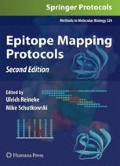Summary
Epitopes presented by major histocompatibility complex (MHC) class I molecules for cytotoxic T-lymphocyte (CTL) recognition are derived mainly from cytosolic proteins. Antigen presentation on the cell surface requires correct processing of epitopes by the proteasome, cytosolic and endoplasmic reticulum (ER) aminopeptidases, efficient TAP transport, and sufficient binding to MHC class I molecules. The efficiency of the epitope generation depends not only on the epitope itself but also on its flanking regions. To investigate preferences at the C-terminal epitope extension on processing and presentation, the SIINFEKL (S8L) epitope can be used as a model epitope. By exchanging the amino acids at the C-terminus of S8L, their influence on the presentation of S8L can be analyzed.
Access this chapter
Tax calculation will be finalised at checkout
Purchases are for personal use only
References
Pamer, E. and Cresswell, P. (1998) Mechanisms of MHC class I-restricted antigen processing. Annu. Rev. Immunol. 16, 323–358.
Princiotta, M. F., Finzi, D., Qian, S. B., Gibbs, J., Schuchmann, S., Buttgereit, F., Bennink, J. R., and Yewdell, J. W. (2003) Quantitating protein synthesis, degradation, and endogenous antigen processing. Immunity 18, 343–354.
Yewdell, J. W. (2005) The seven dirty little secrets of major histocompatibility complex class I antigen processing. Immunol. Rev. 207, 8–18.
Goldberg, A. L., Cascio, P., Saric, T., and Rock, K. L. (2002) The importance of the proteasome and subsequent proteolytic steps in the generation of antigenic peptides. Mol. Immunol. 39, 147–164.
Goldberg, A. L. (2003) Protein degradation and protection against misfolded or damaged proteins. Nature 426, 895–899.
Rock, K. L., York, I. A., Saric, T., and Goldberg, A. L. (2002) Protein degradation and the generation of MHC class I-presented peptides. Adv. Immunol. 80, 1–70.
Groll, M., Heinemeyer, W., Jager, S., Ullrich, T., Bochtler, M., Wolf, D. H., and Huber, R. (1999) The catalytic sites of 20S proteasomes and their role in subunit maturation: a mutational and crystallographic study. Proc. Natl. Acad. Sci. USA 96, 10976–10983.
Groll, M., Ditzel, L., Lowe, J., Stock, D., Bochtler, M., Bartunik, H. D., and Huber, R. (1997) Structure of 20S proteasome from yeast at 2.4 A resolution. Nature 386, 463–471.
Kisselev, A. F., Akopian, T. N., Woo, K. M., and Goldberg, A. L. (1999) The sizes of peptides generated from protein by mammalian 26 and 20 S proteasomes. Implications for understan-ding the degradative mechanism and antigen presentation. J. Biol. Chem. 274, 3363–3371.
Reits, E., Neijssen, J., Herberts, C., Benckhuijsen, W., Janssen, L., Drijfhout, J. W., and Neefjes, J. (2004) A major role for TPPII in trimming proteasomal degradation products for MHC class I antigen presentation. Immunity 20, 495–506.
York, I. A., Chang, S. C., Saric, T., Keys, J. A., Favreau, J. M., Goldberg, A. L., and Rock, K. L. (2002) The ER aminopeptidase ERAP1 enhances or limits antigen presentation by trimming epitopes to 8–9 residues. Nat. Immunol. 3, 1177–1184.
Craiu, A., Akopian, T., Goldberg, A., and Rock, K. L. (1997) Two distinct proteolytic processes in the generation of a major histocompatibility complex class I-presented peptide. Proc. Natl. Acad. Sci. USA 94, 10850–10855.
Mo, X. Y., Cascio, P., Lemerise, K., Goldberg, A. L., and Rock, K. (1999) Distinct proteolytic processes generate the C and N termini of MHC class I-binding peptides. J. Immunol. 163, 5851–5859.
Stoltze, L., Dick, T. P., Deeg, M., Pommerl, B., Rammensee, H. G., andSchild, H. (1998) Generation of the vesicular stomatitis virus nucleoprotein cytotoxic T lymphocyte epitope requires proteasome-dependent and -independent proteolytic activities. Eur. J. Immunol. 28, 4029–4036.
Rock, K. L. and Goldberg, A. L. (1999) Degradation of cell proteins and the generation of MHC class I-presented peptides. Annu. Rev. Immunol. 17, 739–779.
Porgador, A., Yewdell, J. W., Deng, Y., Bennink, J. R., and Germain, R. N. (1997) Localization, quantitation, and in situ detection of specific peptide-MHC class I complexes using a monoclonal antibody. Immunity 6, 715–726.
Author information
Authors and Affiliations
Corresponding author
Editor information
Editors and Affiliations
Rights and permissions
Copyright information
© 2009 Humana Press, a part of Springer Science+Business Media, LLC
About this protocol
Cite this protocol
Martinez, A.N., Tenzer, S., Schild, H. (2009). T-Cell Epitope Processing (The Epitope Flanking Regions Matter). In: Schutkowski, M., Reineke, U. (eds) Epitope Mapping Protocols. Methods in Molecular Biology™, vol 524. Humana Press. https://doi.org/10.1007/978-1-59745-450-6_29
Download citation
DOI: https://doi.org/10.1007/978-1-59745-450-6_29
Published:
Publisher Name: Humana Press
Print ISBN: 978-1-934115-17-6
Online ISBN: 978-1-59745-450-6
eBook Packages: Springer Protocols

